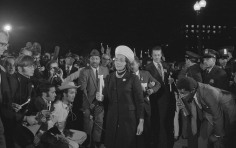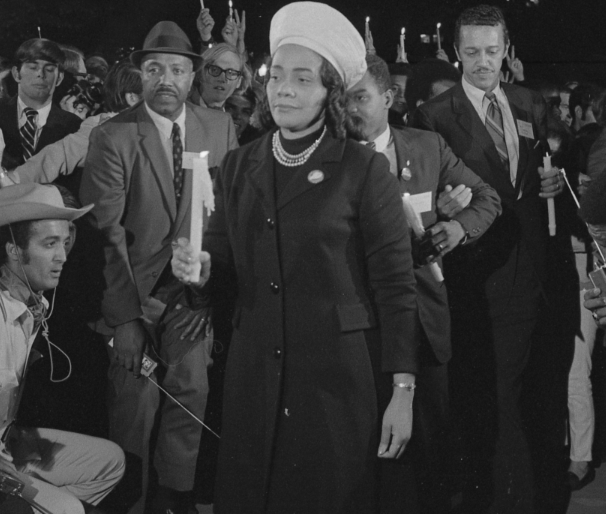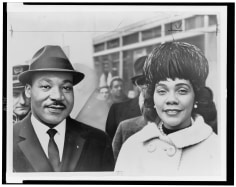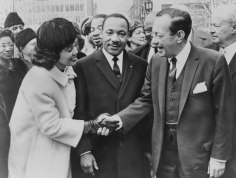
Coretta Scott King holding a candle and leading a march at night to the White House as part of the Moratorium to End the War in Vietnam, 1969.

Courtesy Library of Congress
Essential Question: How did women leaders influence the Civil Rights Movement?
In this lesson students will expand their historical understanding and appreciation of women in the Civil Rights Movement, especially the role of Coretta Scott King as a woman, mother, activist, and wife. Students will also learn about other women leaders in the movement by listening and analyzing first-person interviews from the Interview Archive.
Students will apply historical reading skills of sourcing, contextualization, and corroboration and broaden their skills and use of close reading strategies by analyzing historical images, documentary film, and first-person interviews alongside the transcript. As a demonstration of learning and/or assessment, students will write an argumentative essay expanding on their understanding of women in the Civil Rights Movement through a writing prompt. Through this process, students will continue to build upon the essential habits of a historian and establish a foundation for critical media literacy.
Materials: Equipment for projecting photographs, viewing film clips, and copies of handouts
Length: One 50-minute class period plus a writing assessment
Students will use historical reading skills and increase historical understanding of women in the Civil Rights Movement by:
* Analyzing primary source materials including photographs and documents
* Critically viewing documentary film and first person interviews to inform their understanding of the lesson topic
* Synthesizing new learning through developing questions for further historical inquiry
* Demonstrating their understanding of the lesson topic through a final writing exercise
Teacher Note: Have students discuss or respond in writing to these questions:
* What leadership roles did women hold in the Civil Rights Movement?
* Were the opportunities and obstacles they faced specific to women during this period?
* What do you know about Coretta Scott King?
Teacher Note: Students will analyze and “read” visual sources as if they were employing literary analysis skills. Project or print and distribute the photographs under the “Images” title on this page and have students discuss the questions in small groups.
* What do you see happening in each photograph?
* What story does each individual photograph tell?
* What larger story do the photographs tell when viewed together?
* What questions would you ask the photographers about these photos?
* How can we know that these images are accurate?
* Do you trust what you see in the images? Why or why not?
Have students write questions they have about women’s roles in general, and Coretta Scott King’s role in particular, in the Civil Rights Movement that were sparked by seeing these photographs.
Teacher Note: In this clip we learn about the important role Coretta Scott King navigated as a woman, wife, mother, and activist in the Civil Rights and the anti-war movement.
Distribute Handout 1: Coretta Scott King Note Catcher in Resources section. Review the Note Catcher questions to help students watch the film clips actively and with critical eyes. You may choose to watch the clips more than once so students can collect detailed notes.
Watch Clip 1: “Women in the Movement” (run time 3:18), in "Film Clips" section.
Have students share their notes from the Note Catcher in pairs or as a large group.
Habit of a Historian
After having seen the photos and watched the film clip, have students write down questions that were sparked about Coretta Scott King’s role in the Civil Rights Movement, or the role of other women.
Teacher Note: The film-makers conducted 19 interviews to produce King in the Wilderness. The complete interviews and academic notes for each interviewee are available at www.kunhardtfilmfoundation.org/interview-archive.
For each lesson, interview segments that were not used in the film, but contain insights relevant to the lesson topic, are edited together to create “interview threads.“ There are two interview threads in this lesson that teachers and students can choose from, or use together, to deepen their understanding.
If students have not discussed these questions prior to watching the interview thread(s), discuss:
*What is the value of first-person accounts, like those featured in the interview threads, that is different from other kinds of historical sources?
*What questions arise from using memories as a historical source?
Print and distribute Handout 2 and Handout 3 in "Resources" section.
Watch the Interview Threads
As they watch, students will:
* Follow along on the transcript.
* Underline details that catch their attention.
* Jot down questions and insights that come to mind after viewing the threads.
Thread One: Coretta Scott King (run time 11:10)
Featuring Andrew Young, Xernona Clayton, and Sam Massell
Thread Two: Other Leaders (run time 10:51)
Featuring Diane Nash, Marian Wright Edelman, Clifford Alexander, and Dorothy Cotton
Discuss:
* What do we learn from the first-person accounts featured in these interview threads that are different from other kinds of historical sources?
Teacher Note: After viewing and reading the interview threads, have students choose one or more historical detail to practice their habit of sourcing and corroborating - in other words, research and identify a credible historical source that will verify the detail they selected from the interview. Here are some questions to keep in mind:
* Where did you find the document? Is it credible? How do you know?
* What is the date and who is the author? When is this important?
* How does the source confirm the detail selected from the interview?
* What other sources can you use to help you better understand memories and recollections as a historical resource?
Here are suggested archives to use to find corroborating evidence:
1. The King Center
2. Stanford University: The Martin Luther King, Jr. Research and Education Institute
3. Library of Congress
Discuss:
*How does viewing all these historical sources contribute to your understanding of Coretta Scott King’s influence, and the influence of other women, in the Civil Rights Movement?
*What can we extrapolate from this lesson about how women’s roles in the Civil Rights Movement and other events in history were recognized and documented?
Habit of a Historian
After completing the lesson, have students note what answers they found to previous questions, or identify new questions they’d like to explore.

Coretta Scott King holding a candle and leading a march at night to the White House as part of the Moratorium to End the War in Vietnam, 1969.

Dr. & Mrs. Martin Luther King Jr., head-and-shoulder portrait, facing front, 1965.

Coretta Scott King shakes hands with New York City Mayor Robert Wagner as Dr. Martin Luther King, Jr. stands between them, 1964.
In King in the Wilderness, Xernona Clayton, friend and colleague of Dr. King and Coretta Scott King, shared:
“Coretta believed in [Dr. King’s] cause so much that she was willing to pay the price, and she tried hard to have him spend as much time with the children as he could cause he wasn’t home that much.”
As an assessment, have students write an essay expanding on the phrase “to pay the price” in the context of leadership roles and influence of women in the Civil Rights Movement. Students can refer to any of the historical source material included in the lesson or resources they discover through independent research.
Anchor Standards
Reading Literature and/or Information: Integration of Knowledge and Ideas.
RL/RI.X.7. Integrate and evaluate content presented in diverse media and formats, including visually and quantitatively, as well as in words.
RL/RI.X.8. Delineate and evaluate the argument and specific claims in a text, including the validity of the reasoning as well as the relevance and sufficiency of the evidence.
RL/RI.X.9. Analyze how two or more texts address similar themes or topics in order to build knowledge or to compare the approaches the authors take.
Speaking and Listening: Comprehension and Collaboration
SL.X.1 Prepare for and participate effectively in a range of conversations and collaborations with diverse partners, building on others’ ideas and expressing their own clearly and persuasively.
SL.X.2. Integrate and evaluate information presented in diverse media and formats, including visually, quantitatively, and orally
SL.X.3 Evaluate a speaker’s point of view, reasoning, and use of evidence and rhetoric.
Writing: Research to Build and Present Knowledge.
W.X.7: Conduct short as well as more sustained research projects based on focused questions, demonstrating understanding of the subject under investigation.
W.X.8 Gather relevant information from multiple print and digital sources, assess the credibility and accuracy of each source, and integrate the information while avoiding plagiarism
